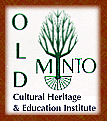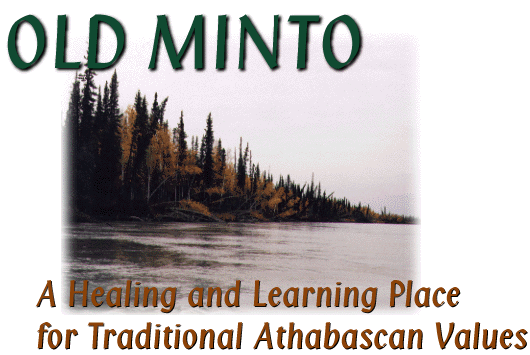

Cultural Heritage
Camp
![]() In
1989 CHEI was able to implement the Cultural Heritage Camp
idea that Robert Charlie, his wife Kathy, and Ray Barnhardt
(of the University of Alaska's (UAF) Education Department
and the Alaska Native Knowledge Network) developed as a way
to help to preserve Old Minto.
In
1989 CHEI was able to implement the Cultural Heritage Camp
idea that Robert Charlie, his wife Kathy, and Ray Barnhardt
(of the University of Alaska's (UAF) Education Department
and the Alaska Native Knowledge Network) developed as a way
to help to preserve Old Minto.
![]() That
year, the first group of camp participants cut and cleared
20-years of accumulated brush, raised a cooking tent, built
fish drying racks and cutting tables, assembled a dining
area, and dug four outhouse holes.
That
year, the first group of camp participants cut and cleared
20-years of accumulated brush, raised a cooking tent, built
fish drying racks and cutting tables, assembled a dining
area, and dug four outhouse holes.
![]() Since
that first year, approximately four hundred Alaskan and
"Lower 48 States" people have attended these camps to learn
first-hand about Athabascan life. These many vistitors have
included teachers from UAF's Graduate Education Program and
students participating in World Horizons International, a
non-profit organization that brings students from New York
to learn more about other cultures. The "Youth-at-Risk Camp"
is another program, federally funded, which brings young
people with troubled backgrounds to Old Minto to provide
them with an opportunity to learn more about and instill
pride in them of their Athabascan culutre and its
traditional ways.
Since
that first year, approximately four hundred Alaskan and
"Lower 48 States" people have attended these camps to learn
first-hand about Athabascan life. These many vistitors have
included teachers from UAF's Graduate Education Program and
students participating in World Horizons International, a
non-profit organization that brings students from New York
to learn more about other cultures. The "Youth-at-Risk Camp"
is another program, federally funded, which brings young
people with troubled backgrounds to Old Minto to provide
them with an opportunity to learn more about and instill
pride in them of their Athabascan culutre and its
traditional ways.
![]() Old
Minto provides a rich environment for learning many things.
"One of the things I learned at this camp was the element of
patience," Marcia (a teacher at Glennallen, Alaska) remarked
after her camp experience in 1998. "I come from the East
where everything always has to get done very, very, very
fast. At Old Minto, there was just a whole different
perspective of time, knowing everything would get
accomplished but you didn't have to put this undue stress on
yourself to get these accomplishments done-and...everything
did get done. It's a different rhythm, a different
pace...you can take time to enjoy what you're
doing."
Old
Minto provides a rich environment for learning many things.
"One of the things I learned at this camp was the element of
patience," Marcia (a teacher at Glennallen, Alaska) remarked
after her camp experience in 1998. "I come from the East
where everything always has to get done very, very, very
fast. At Old Minto, there was just a whole different
perspective of time, knowing everything would get
accomplished but you didn't have to put this undue stress on
yourself to get these accomplishments done-and...everything
did get done. It's a different rhythm, a different
pace...you can take time to enjoy what you're
doing."
![]() Native elders, originating from throughout Alaska and
primarily Minto, teach camp participants about native
culture and native ways of knowing. As members of the last
generation to have participated fully in their traditional
Alaska native cultures, the elders hope to convey their
knowledge to as many people as possible.
Native elders, originating from throughout Alaska and
primarily Minto, teach camp participants about native
culture and native ways of knowing. As members of the last
generation to have participated fully in their traditional
Alaska native cultures, the elders hope to convey their
knowledge to as many people as possible.
![]() Geraldine
Charlie, an Elder and teacher from Minto teaches birchbark
weaving. Camp participant Jennifer McCarty observed that
"Geraldine sat in front or her tent all day as a steady
stream of students stopped by to learn how to make birchbark
canoes, baskets or picture frames. The whole time, she
remained patient and cheerful and didn't get up from
teaching...Even after an entire day of teaching students,
she still worked at the same pace, showing us, a pattern,
getting out the pieces of birchbark, cutting it for us,
searching for the right size of split willow roots to sew
with and thin willow branches for the edges." McCarty also
noted that "Whenever an Elder would teach us how to do
something, they would merely act as guides...They would give
the occasional suggestion if they knew a way that would help
get the job done better, but they would never make any
discouraging remarks. They were always full of
compliments."
Geraldine
Charlie, an Elder and teacher from Minto teaches birchbark
weaving. Camp participant Jennifer McCarty observed that
"Geraldine sat in front or her tent all day as a steady
stream of students stopped by to learn how to make birchbark
canoes, baskets or picture frames. The whole time, she
remained patient and cheerful and didn't get up from
teaching...Even after an entire day of teaching students,
she still worked at the same pace, showing us, a pattern,
getting out the pieces of birchbark, cutting it for us,
searching for the right size of split willow roots to sew
with and thin willow branches for the edges." McCarty also
noted that "Whenever an Elder would teach us how to do
something, they would merely act as guides...They would give
the occasional suggestion if they knew a way that would help
get the job done better, but they would never make any
discouraging remarks. They were always full of
compliments."
![]() The
elders instruct by demonstrating a wide variety of
traditional activities, including fisheries practices, fish
preservation, outdoors skills, weather prediction,
wilderness navigation, birch bark/spruce root basketry,
beading, canoe construction, traditional native dress, dance
composition, storytelling, and singing.
The
elders instruct by demonstrating a wide variety of
traditional activities, including fisheries practices, fish
preservation, outdoors skills, weather prediction,
wilderness navigation, birch bark/spruce root basketry,
beading, canoe construction, traditional native dress, dance
composition, storytelling, and singing.
![]() During
their stay participants have the unique opportunity
to:
During
their stay participants have the unique opportunity
to:
- Live in a remote Alaskan river village
- Gain greater insight into the traditional Athabascan culture, ways of life, and people
- Learn more about an Interior Alaskan non-profit organization striving to bridge urban and rural ways of life
![]() Old Minto is currently available to be used as a retreat
center for businesses, individuals, and other special
programs, hosting a variety of Athabascan culture-related
seminars, workshops, survival training, and arts/crafts
skills training. Proponents of these programs suggest that
cross-cultural orientation sessions, such as those offered
at Old Minto, are needed as training for locally-based
federal, state, and corporate/business agencies to better
serve their local community.
Old Minto is currently available to be used as a retreat
center for businesses, individuals, and other special
programs, hosting a variety of Athabascan culture-related
seminars, workshops, survival training, and arts/crafts
skills training. Proponents of these programs suggest that
cross-cultural orientation sessions, such as those offered
at Old Minto, are needed as training for locally-based
federal, state, and corporate/business agencies to better
serve their local community.
![]() With recent budgetary cuts in the larger local social
service agencies, a greater need now exists for accessible
programs such as recovery services for dysfunctional
families and individuals. CHEI hopes to meet these
community-based needs by increasing the quantity of its
culture camp programs, extending them to be offered
throughout the year, and thus reaching a greater population.
The first step for this proposed growth is the intended
cabin
restoration project.
With recent budgetary cuts in the larger local social
service agencies, a greater need now exists for accessible
programs such as recovery services for dysfunctional
families and individuals. CHEI hopes to meet these
community-based needs by increasing the quantity of its
culture camp programs, extending them to be offered
throughout the year, and thus reaching a greater population.
The first step for this proposed growth is the intended
cabin
restoration project.
![]() Accomodations
at the camp are rustic, but reasonably comfortable. While at
the camp, participants and staff live in tents, re-creating
the environment and activities of an Athabascan summer
fishing camp. Sleeping quarters consist of either small
tents brought by camp participants, or multi-person canvas
wall tents provided by the camp. CHEI provides wooden bunks
and foam pads. A staffed camp kitchen and communal dining
area provide three meals per day and snacks. There is no
piped pressure water system at the site and potable water is
hauled from a nearby well. River water is filtered for
washing dishes, bathing, etc. and all water must be heated
over a stove or fire. Toilet facilities consist of
outhouses.
Accomodations
at the camp are rustic, but reasonably comfortable. While at
the camp, participants and staff live in tents, re-creating
the environment and activities of an Athabascan summer
fishing camp. Sleeping quarters consist of either small
tents brought by camp participants, or multi-person canvas
wall tents provided by the camp. CHEI provides wooden bunks
and foam pads. A staffed camp kitchen and communal dining
area provide three meals per day and snacks. There is no
piped pressure water system at the site and potable water is
hauled from a nearby well. River water is filtered for
washing dishes, bathing, etc. and all water must be heated
over a stove or fire. Toilet facilities consist of
outhouses.
Please contact us!

Old Minto Cultural Heritage and
Educational Institution
Comments or Suggestions? Please contact the Webmaster.
![]()